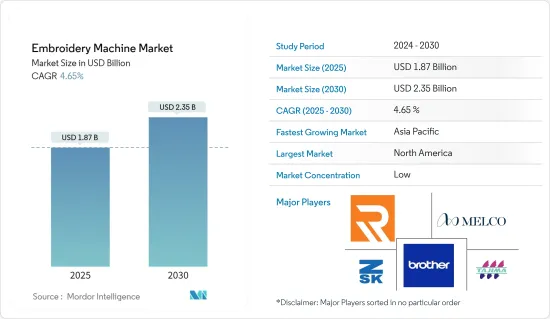
|
시장보고서
상품코드
1651068
자수기 시장 : 시장 점유율 분석, 산업 동향 및 통계, 성장 예측(2025-2030년)Embroidery Machine - Market Share Analysis, Industry Trends & Statistics, Growth Forecasts (2025 - 2030) |
||||||
자수기 시장 규모는 2025년에 18억 7,000만 달러로 추정되고, 예측 기간(2025-2030년)의 CAGR은 4.65%로 전망되며, 2030년에는 23억 5,000만 달러에 달할 것으로 예측되고 있습니다.

자수기 시장은 최근 몇 년동안 크게 성장하고 있습니다. 커스터마이즈나 자수 수요, 기술의 진보, 섬유 및 의류 산업의 성장 등의 요인이 이 성장에 기여하고 있습니다. 주요 시장 진출기업은 기계의 능력을 향상시키기 위해 끊임없이 기술 혁신을 실시했습니다.
주요 하이라이트
- 보다 빠른 봉제 속도, 보다 우수한 정확도, 사용하기 쉬운 인터페이스를 제공합니다. 시장은 중국, 인도, 일본 등 아시아태평양 국가가 지배적입니다. 이 나라들은 자수 기계의 생산과 소비에 중요한 역할을 합니다. 아시아태평양의 섬유 산업은 급속히 확대되고 있으며, 개인화된 자수와 자수 제품의 동향은 증가하는 경향이 있습니다.
- 아시아태평양 외에도 북미와 유럽도 시장에서 중요한 역할을 하고 있습니다. 맞춤형 독특한 텍스타일의 인기가 높아지고 있으며, 시장은 컴퓨터화된 자동 기계로 이동하여 보다 효율적이고 복잡한 디자인을 가능하게 합니다.
- AI와 자동화 등의 기술 혁신이 산업을 바꾸고 있습니다. 이러한 혁신은 효율성을 향상시키고, 수작업을 줄이고, 보다 유연한 디자인을 제공함으로써 다양한 최종 사용자 산업에서 자수기의 채택을 촉진합니다.
자수기 시장 동향
다두식 자수기의 성장-두수는 많은 편이 좋습니다.
다두침 자수기의 미래는 밝습니다. 한편, 단일바늘 자수기은 조금 열기가 부족합니다. 단일 바늘 자수기의 역사는 깁니다. 그럼에도 불구하고 중소기업 경영자들이 단일 바늘 자수기를 사용하여 사업을 수행하는 한계를 깨닫기 시작한 것은 매우 최근입니다.
복수의 재봉기 헤드가 장착된 자수 기계는 동일한 옷과 직물의 여러 부분을 동시에 꿰매어 놓을 수 있습니다. 즉, 복수의 헤드가 자수기의 같은 부분에 동시에 작업할 수 있기 때문에 단일 바늘 자수기에 비해 자수기의 효율과 생산량이 대폭 향상됩니다.
다두식 자수기는 특히 대량의 자수 제품을 생산해야 하는 섬유 및 의류 산업 기업에서 사용됩니다. 즉, 다두식 자수기는 대량 주문에 대응해야 하는 제조업체에게 최적의 선택입니다.
하나의 자수기로 여러 개의 헤드가 동시에 동일한 자수 제품을 사용하면 단일 배치를 완성하는 데 필요한 시간이 크게 단축됩니다. 이는 엄격한 납기를 지키고 생산 일정을 최적화해야 하는 기업에게 특히 중요합니다.
아시아태평양이 우위를 차지합니다.
아시아태평양에는 중국, 인도, 일본 등 세계 최대의 의류 시장이 있습니다. 중국은 세계 최대의 의류 제품 수출국입니다. 방글라데시와 베트남은 세계의 의류 수출국 상위 5위에 들어 있습니다. 아시아의 일부 경제권은 대규모 GTF(의류, 섬유제품, 양말) 제조업을 가지고 있습니다.
의류, 섬유제품 및 양말 산업은 아시아 경제에서 중요한 역할을 계속하고 있으며, 아시아 지역의 약 6,000만 명에게 고용을 제공하고 간접 고용의 형태로 수백만 명을 더 지원합니다.
섬유 산업은 동아시아의 대부분에서 계속 성장하고 있으며, 그 중에서도 중국, 베트남, 인도네시아, 캄보디아의 성장률이 가장 높습니다. 이 지역에는 나이키와 자라, C&A, H&M 등 유럽 패션산업의 선두가 진출하고 있습니다. 섬유 제품은 유럽 소비로 인한 환경 부하의 4위를 차지합니다.
세계 최대의 의류 생산국인 동아시아 지역은 세계 섬유 및 의류 공급망에서 중요한 역할을 하고 있으며, 2019년에는 세계 섬유 수출의 약 55%를 차지했습니다.
베트남만으로도 2022년에는 추정 376억 달러 상당의 의류, 의류, 섬유제품이 세계로 수출되었으며 그 중 58억 달러가 수출되었습니다. EFTA와 EU 베트남 자유무역협정이라는 두 가지 자유무역협정의 실시로 동남아시아에 대한 참여가 높아진 경우도 있어, 동산업은 급성장을 계속하고 있습니다. 유럽 경제 영역 자유 무역 협정(EU-베트남 자유 무역 협정)의 결과, 베트남 제품은 EU 시장에 대한 의존도를 높이고 있습니다. 그러나 COVID-19가 발생한 이래 동아시아의 의류 및 섬유 산업은 유럽연합(EU)과 미국(미국) 등 주요 시장에서 수요 감소의 영향을 받고 있습니다. 또한 인도네시아, 말레이시아, 태국, 베트남 시장에서 섬유 제품 수출도 2020년에 감소했습니다.
자수기 산업 개요
자수기 시장은 세분화되어 있으며 많은 진출기업이 시장에 진출하고 있습니다. 주요 진출기업으로는 Brother Industries, Ltd, Bernina International AG, Tajima Industries Ltd 등이 있습니다. 세계의 자수기 시장은 기술의 진보, 주문 제품에 대한 소비자 기호의 고조, 섬유 및 의류 산업의 세계의 성장에 의해 증가 경향에 있습니다.
기타 혜택
- 엑셀 형식 시장 예측(ME) 시트
- 3개월간의 애널리스트 서포트
목차
제1장 서론
- 조사의 전제조건
- 조사 범위
제2장 조사 방법
제3장 주요 요약
제4장 시장 인사이트
- 현재의 시장 시나리오
- 정부의 규제 및 대처
- 기술 동향
- COVID-19가 시장에 미치는 영향
제5장 시장 역학
- 시장 성장 촉진요인
- 패션과 섬유산업의 성장이 시장 견인
- 컴퓨터 자수기 수요 증가
- 시장 성장 억제요인
- 높은 가동 비용
- 시장 기회
- 기술의 진보와 자동화
- Porter's Five Forces 분석
- 공급기업의 협상력
- 소비자 및 구매자의 협상력
- 신규 진입업자의 위협
- 대체품의 위협
- 경쟁 기업간 경쟁 관계의 강도
제6장 시장 세분화
- 유형별
- 프리모션 자수기
- 코넬리 안내 자수기
- 시후리 자수기
- 최종 사용자별
- 주택용
- 업무용
- 지역별
- 북미
- 미국
- 캐나다
- 멕시코
- 유럽
- 프랑스
- 독일
- 이탈리아
- 스페인
- 기타 유럽
- 아시아태평양
- 인도
- 중국
- 일본
- 한국
- 기타 아시아태평양
- 중동 및 아프리카
- 아랍에미리트(UAE)
- 사우디아라비아
- 기타 중동 및 아프리카
- 남미
- 북미
제7장 경쟁 구도
제8장 개요(시장 집중도와 주요 기업)
제9장 기업 프로파일
- Brother Industries, Ltd.
- Bernina International AG
- Janome Sewing Machine Co., Ltd.
- Tajima Industries Ltd.
- ZSK Stickmaschinen GmbH
- Ricoma International Corporation
- Melco International
- PFAFF Industriesysteme und Maschinen GmbH
- Singer Sewing Company
- SWF Embroidery Machines
제10장 *목록 전체가 아님
제11장 시장 전망 시장의 미래
제12장 시장 부록
AJY 25.02.26The Embroidery Machine Market size is estimated at USD 1.87 billion in 2025, and is expected to reach USD 2.35 billion by 2030, at a CAGR of 4.65% during the forecast period (2025-2030).

The market for embroidery machines has grown significantly in recent years. Factors such as customization and embroidery demand, technological advancement, and the growth of the textile and apparel industry have contributed to this growth. Key market players are constantly innovating to improve machine capabilities.
Key Highlights
- They offer faster stitching speed, better precision, and easy-to-use interfaces. The market is dominated by Asia-Pacific countries such as China, India, and Japan. These countries play a major role in the production and consumption of embroidery machines. The textile industry in Asia-Pacific is expanding rapidly, and the trend of personalized embroidery and embroidery products is on the rise.
- In addition to Asia-Pacific, North America and Europe are also playing an important role in the market. Customized and unique textiles are becoming increasingly popular, and the market has shifted towards computerized and automatic machines, allowing for more efficient and complex designs.
- Technological innovations, such as AI and automation, are changing the industry. These innovations improve efficiency, reduce manual labor, and provide more design flexibility, which is driving the adoption of Embroidery machines across different end-user industries.
Embroidery Machine Market Trends
Multi-head Embroidery Machines are growing - More heads are better than one
Multi-needle embroidery machines have a bright future ahead of them. Single-needle machine embroidery machines, on the other hand, are a bit less exciting. Single-needle sewing machines have been around for a long time. Still, it's only recently that small business owners have started to realize the limitations of using a single-needle machine to run a business.
Embroidery machines with multiple sewing heads can work on different areas of the same garment or fabric at the same time. This means that multiple heads can work on the same part of the embroidery machine at the same time, significantly increasing the efficiency and output of the machine compared to a single-head machine.
Multi-head machines are used by businesses, particularly in the textiles and apparel industry, that need to produce large amounts of embroidery products. This means that multi-head machines are the best choice for manufacturers that have to deal with high-volume orders.
When multiple heads are working on the same embroidery product at the same time on the same machine, the amount of time needed to complete one batch of embroidery decreases significantly. This is especially important for businesses that need to meet tight deadlines and optimize their production schedules.
Asia- Pacific is dominating the region
Asia-Pacific region is home to some of the world's largest apparel markets, such as China, India, and Japan. China is the world's largest exporter of apparel products. Bangladesh and Vietnam are among the top five apparel exporters in the world. Several Asian economies have significant GTF (garment, textiles, and footwear) manufacturing industries.
The garment, textiles, and footwear industries continue to play a vital role in Asian economies, providing employment for around 60 million people in the region and supporting millions more in the form of indirect employment.
The textile sector continues to grow in most of East Asia, with the highest growth rates observed in China, Vietnam, Indonesia, and Cambodia. This region is home to some of the biggest names in the European fashion industry, such as Nike and Zara, as well as C&A, H&M, and others. Textiles represent the fourth largest environmental impact due to European consumption.
As the world's largest garment producer, the East Asian region plays a significant role in the global textiles and apparel supply chain, accounting for around 55 percent of global textile exports in 2019.
Vietnam alone exported an estimated USD 37.6 billion worth of apparel, garments, and textile products to the world in 2022, of which USD 5.8 billion. The industry continues to grow rapidly, partly due to increased involvement in Southeast Asia due to the implementation of the two free trade agreements, the EFTA and the EU-Vietnam free trade agreement. As a result of the European Economic Area Free Trade Agreement (EU-Vietnam Free Trade Agreement), Vietnamese goods have become increasingly dependent on the EU market. However, since the outbreak of COVID-19, the garment and textile industries in East Asia have been affected by a decrease in demand in key markets such as the European Union (EU) and the United States (U.S.). In addition, textile exports from the Indonesian, Malaysian, Thai, and Vietnamese markets also decreased in 2020.
Embroidery Machine Industry Overview
The embroidery machine market is fragmented, with many players operating in the market. Some of the major players in the market are Brother Industries, Ltd, Bernina International AG, Tajima Industries Ltd, and many more. The global market for embroidery machines is on the rise due to technological advancements, growing consumer preferences for bespoke items, and the global growth of the textile and apparel industries.
Additional Benefits:
- The market estimate (ME) sheet in Excel format
- 3 months of analyst support
TABLE OF CONTENTS
1 INTRODUCTION
- 1.1 Study Assumptions
- 1.2 Scope of the Study
2 RESEARCH METHODOLOGY
3 EXECUTIVE SUMMARY
4 MARKET INSIGHTS
- 4.1 Current Market Scenario
- 4.2 Government Regulations and Initiatives
- 4.3 Technological Trends
- 4.4 Impact of COVID-19 on the Market
5 MARKET DYNAMICS
- 5.1 Market Drivers
- 5.1.1 Growth in Fashion and Textile Industry is driving the market
- 5.1.2 Rise in the demnad for Computerized Embroidery Machines
- 5.2 Market Restraints
- 5.2.1 High Operating Costs
- 5.3 Market Opportunities
- 5.3.1 Technological Advancements and Automation
- 5.4 Porter's Five Forces Analysis
- 5.4.1 Bargaining Power of Suppliers
- 5.4.2 Bargaining Power of Consumers/Buyers
- 5.4.3 Threat of New Entrants
- 5.4.4 Threat of Substitute Products
- 5.4.5 Intensity of Competitive Rivalry
6 MARKET SEGMENTATION
- 6.1 By Type
- 6.1.1 Free Motion Embroidery Machine
- 6.1.2 Cornely Hand Guided Embroidery Machine
- 6.1.3 Schiffli Embroidery Machine
- 6.2 By End -User
- 6.2.1 Residential
- 6.2.2 Commercial
- 6.3 By Geography
- 6.3.1 North America
- 6.3.1.1 USA
- 6.3.1.2 Canada
- 6.3.1.3 Mexico
- 6.3.2 Europe
- 6.3.2.1 France
- 6.3.2.2 Germany
- 6.3.2.3 Italy
- 6.3.2.4 Spain
- 6.3.2.5 Rest of Europe
- 6.3.3 Asia-Pacific
- 6.3.3.1 India
- 6.3.3.2 China
- 6.3.3.3 Japan
- 6.3.3.4 South Korea
- 6.3.3.5 Rest of Asia-Pacific
- 6.3.4 Middle East and Africa
- 6.3.4.1 UAE
- 6.3.4.2 Saudi Arabia
- 6.3.4.3 Rest of Middle East and Africa
- 6.3.5 South America
- 6.3.1 North America
7 COMPETITIVE LANDSCAPE
8 Overview (Market Concentration and Major Players)
9 Company Profiles
- 9.1 Brother Industries, Ltd.
- 9.2 Bernina International AG
- 9.3 Janome Sewing Machine Co., Ltd.
- 9.4 Tajima Industries Ltd.
- 9.5 ZSK Stickmaschinen GmbH
- 9.6 Ricoma International Corporation
- 9.7 Melco International
- 9.8 PFAFF Industriesysteme und Maschinen GmbH
- 9.9 Singer Sewing Company
- 9.10 SWF Embroidery Machines



















